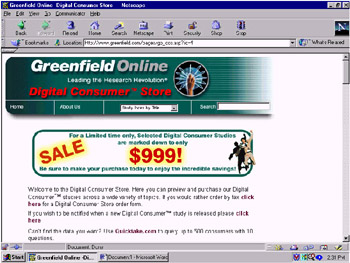BACKGROUND
|
|
While the benefits of gathering market data over the Internet may seem obvious today, the practice was quite novel in 1993. The idea came to Greenfield Online founder Hugh Davis when he was a sophomore studying economics at Fairfield University in Fairfield, Connecticut. As a student paying his way through college, Hugh responded to a campus ad offering students $10/hour to call people to recruit them for marketing studies being conducted by the Greenfield Consulting Group. For one study requiring input from college students, Hugh sent an e-mail message to about 15 of his friends, asking them to respond and then forward the survey to others. The next morning he had over 100 responses. When Hugh reported this to Andy Greenfield, Andy wanted to know how Hugh had accomplished the data collection so quickly. Once Hugh explained what e-mail was and how much it cost (i.e., nothing), its potential was clear to Mr. Greenfield.
Andy Greenfield then began providing financial support for Hugh Davis to develop the concept of online market research data collection. Hugh started working full-time while continuing his college studies. When he graduated in 1995, Hugh and teammates Steve Cook and Paul Jacobson were well beyond proof-of-concept. Greenfield's online market research had proven to be very profitable, and by 1996 the company had grown to 14 people.
To continue to fuel this tremendous growth, Andy Greenfield invested several million dollars of his own money, and outside funding was also attracted. Rudy Nadilo was brought in as CEO, and the company grew to 48 people by mid-1999. At that point, with $20 million in venture capital funding, the seven-person management team bought the company from Hugh Davis, Andy Greenfield and Rudy Nadilo. Michael Dell of Dell Computers, Compaq Computer and other sources then invested additional capital. In the early part of the year 2000, Greenfield Online filed to go public, but withdrew the proposed IPO later that year when it was clear that stock-market conditions were unfavorable.
Through the early part of 2001, Greenfield Online continued to experience rapid growth. Staff members had developed and conducted studies for more than 500 clients, including many Fortune 100 firms. A key to their business model was the acquisition and development of people to participate in their studies. This participation took the form of an "online community" where members called "panelists" were invited by email and paid an incentive to participate in targeted marketing studies. As of February 2001, over 2.2 million people had volunteered to join Greenfield's online panel.
Panelists enjoy a variety of perks for being members and participating in surveys. Members provide detailed demographic and lifestyle profiles, filling in a total of more than 70 fields of information. Greenfield zealously guards their privacy, providing only aggregated information to clients. A key component to Greenfield's success is the efficient way they manage the online community. Greenfield tailors each individual email invitation, and they track and record the email messages that each member receives.
With its large, diverse set of panelists responding from home, Greenfield has capabilities that cannot be matched by firms using traditional, off-line methods. For example, a survey for a cold remedy product can be conducted using a large sample of people who are currently home sick with a cold. Online focus groups can also be conducted, with at-home privacy enabling franker and richer responses. Products, websites and video clips can be shown to participants online, and data is available to clients immediately at the end of a focus group session. On-line data gathering dramatically reduces the time and cost of conducting a market research study. Using Greenfield's "QuickTake" system, customers could develop and implement a survey themselves in a day for as little as $1000. Most customers elect for full service, however. The typical study conducted by Greenfield Online, including questionnaire development and results analysis services, cost a client approximately $35,000 in early 2001. The average study took 2–4 weeks to complete, which is significantly less than the four to eight weeks required to perform a comparable study off-line.
The Digital Consumer Store was an off-shoot of the company's mainline business. The DCS followed a typical e-business "storefront" model, whereas Greenfield's online community, with its membership perks, had elements of a "free products and services" model (see Chapter 2 of Deitel, Deitel and Steinbuhler (2001) for a discussion of e-business models). Tracking study results, each providing data for a particular topic or industry, were available as downloadable products through the DCS.
The reports available through Greenfield's DCS were part of their syndicated data services, which as a whole accounted for approximately 6 % of corporate revenues in early 2001. An example of a DCS product is a report entitled "Cruising for Cars," which analyzed responses from 2,000 panelists who had shopped for a vehicle on the Internet in the 12 months prior to August 2000. DCS reports such as this were available as off-the-shelf items at a cost of $999 each.
While the customer interface for the DCS reflected state-of-the-art technology (see Figure 1), the "back office" operations behind this interface were relatively archaic. Greenfield staff members manually recorded each order, and several people had to follow up to ensure receipt of payment. In February 2001, Greenfield's management believed there was room for improvement, but they were not sure that the volume of orders received through the DCS could justify the cost of automating the manual parts of the process. Tricia Rosen, Product Development Manager, was asked to evaluate possibilities for streamlining DCS back office operations.

Figure 1: Entry to the Digital Consumer Store
|
|
EAN: 2147483647
Pages: 367